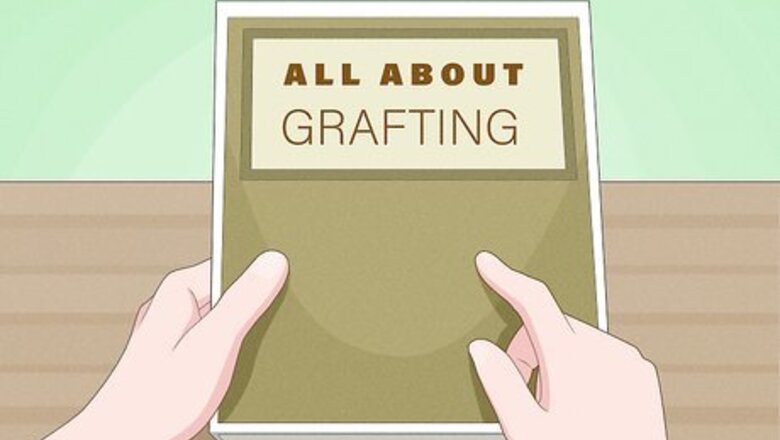
views
Basics of Grafting
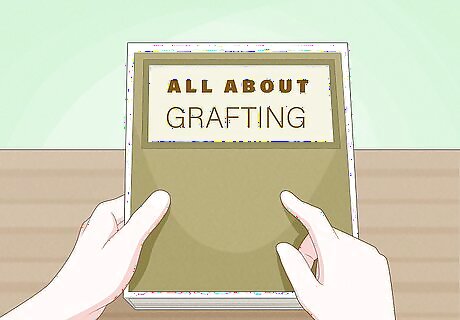
Recognize the benefits and reasons behind grafting. Many plants, including fruits, vegetables, ornamentals, and trees, are grafted and cross-bred over many generations to improve their attributes. By removing the top section of a plant that produces great fruit (also known as the “scion”) and grafting it onto the rootstock of a variety that absorbs nutrients well and resists disease, the plant will grow with the benefits of each variety. Grafting can help create unique ornamentals or produce plants with specialized forms, such as making apple trees grow shorter to plant them in orchards. Grafting two plants that are the same variety doesn’t have any benefits because they’ll already have the same attributes as one another. Seeds from grafted plants will only contain the qualities of the scion and not carry the attributes of the rootstock.
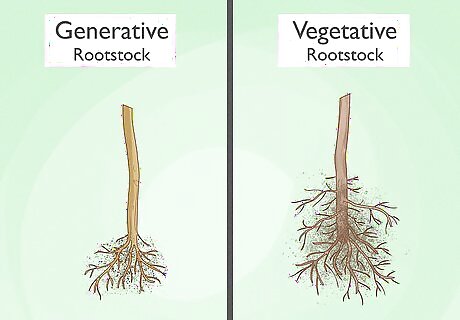
Use high-quality rootstock seeds or plants. The rootstock is the bottom plant in a graft that provides a root system and base. Rootstock seeds are available at most plant nurseries or gardening stores if you want to grow them on your own. Alternatively, choose a plant that has the qualities you’re looking for and has been growing for at least 1 year to use as the rootstock. Generative rootstock puts more energy into producing fruit, but is more vulnerable to disease, cold, and heat. Consider using these in mild climates, such as the Pacific Northwest. Vegetative rootstock tends to be less fragile and handles heat better, but won't produce fruit quickly. Choose a vegetative rootstock for long, hot growing seasons. Pick a rootstock specifically resistant to diseases in your area if you’re able to for better chances of the two plants growing together.
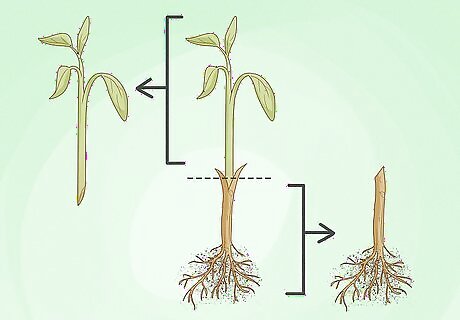
Select a compatible scion that’s in the same species as the rootstock. The scion produces better fruit and is the top part of the plant grafted onto the rootstock. Scions have to be compatible with the rootstock in order to thrive, so look into the specific varieties that work well with your rootstock. If you are running a farm or commercial operation, research which scion plant will produce the type of fruit with the attributes you’re looking for. Example: You could use a French crabapple rootstock to increase disease resistance for other types of apple trees. Example: You may graft different rose varieties together to reduce the size of the plant or to grow differently-colored blooms. Most plants can only be grafted onto a plant of the same species, so a cucumber cannot grow on a tomato plant, for example. Some plants can be grafted onto related species in the same genus or family, but research the specific rootstock you’re using to see what’s compatible.
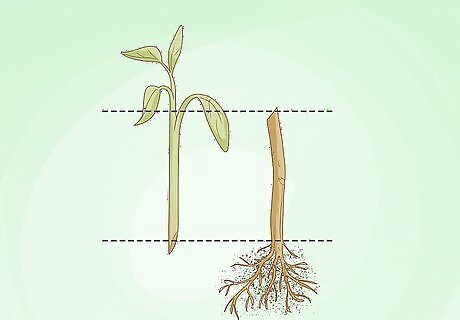
Use scions and rootstocks that are the same size. Grafting is most successful when the rootstock and scion have the same size stem. If you’re growing your own scions and rootstocks, plant the seeds at the same time in separate, labeled containers to tell them apart. If one of the varieties grows faster than the other, time your plantings so they reach the grafting stage at the same time. Plant several seeds of each variety since there's always a chance some won't grow or survive the grafting process. If you're growing a large number of plants, use an online seed calculator to determine how to plant in your area.
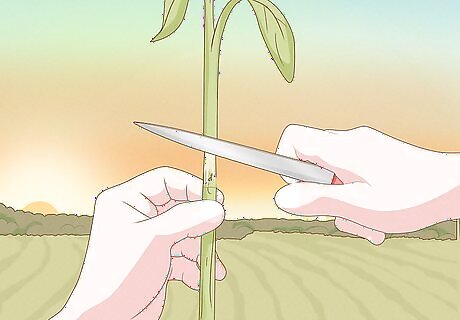
Graft plants during early morning or just after sunset. At these times, the plant will be moving water from its roots to its leaves (transpiring) at a slower rate, which makes it less vulnerable to stress from grafting and the accompanying water loss. Ideally, try to carry out grafting your plants indoors or in a shaded location. If you can’t graft plants in the early morning or late evening, move them to a shady spot until you’re able to do it.
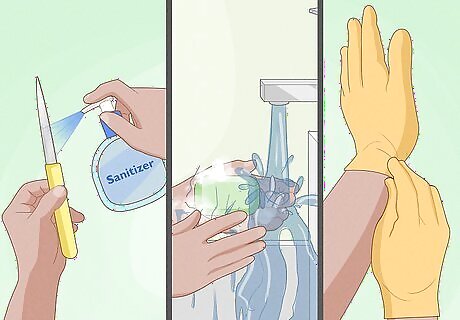
Sanitize your gardening tools to reduce the risk of infection. Wipe down your gardening tools with rubbing alcohol to kill any bacteria on them. Since you’re making an open cut into each plant, keeping your tools as clean as possible helps reduce the chance of an infection. Scrub your hands with anti-microbial soap and put on latex gloves so you don’t transfer any bacteria from your skin to newly grafted plants.
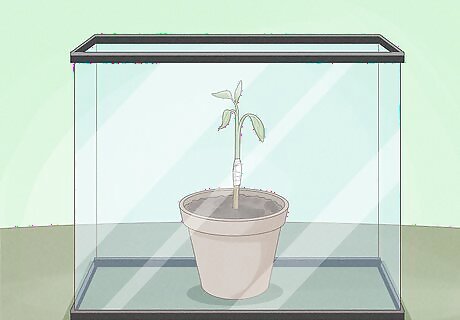
Treat newly grafted plants with special care to help them survive. Plants that have just been grafted are more vulnerable to temperature changes and infection until the plants have sealed together. Be gentle with grafted plants so they’re more likely to survive and to prevent infections from forming. Keep the grafted section protected with wraps around the point where they’re connected, or keep them in separate grow chambers to protect them from the outside elements.
Splice Grafts
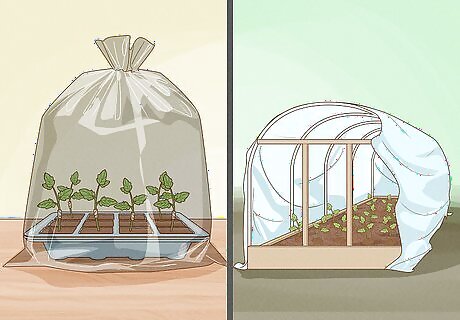
Construct a healing chamber for your plants. A healing chamber allows you to control the environment and humidity around grafted plants to protect them while they’re healing. For one or two plants, simply have a large plastic bag handy to place over each plant after you finish grafting. For a larger number of plants and a better chance of survival, put together garden frames and drape them fully with polyethylene sheeting. Cover the sheets with a shade cloth to block most sunlight from entering the chamber during the first stage of healing. Use a frame with a peaked roof so condensation runs down the sides and doesn't drip onto the plants.
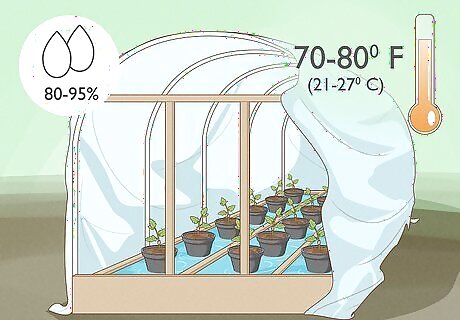
Add trays of water to the chamber and monitor the environment. Place shallow pans of water around the floor of the chamber to increase the humidity inside. Before you graft any plants, monitor the environment in the healing chamber for at least a few days to make sure it is stable. The chamber is ready for grafted plants if the temperature levels are between 70–80 °F (21–27 °C) and the humidity is between 80–95%. Only keep grafted plants inside of the healing chamber because the environment may be too humid for other vegetation.
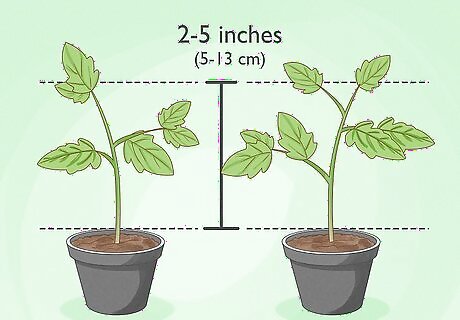
Choose plants that are the same height and diameter. Splice grafting is most successful on plants with stems that are still green (herbaceous) instead of woody. Choose plants that are 2–5 in (5.1–12.7 cm) tall when they have 2–4 true leaves and stems of exactly the same size. Splice grafting works great on tomatoes, peppers, and eggplants. The first one or two leaves that grow on the plant are "seed leaves" and are not the true leaves. Seed leaves usually have a different shape or size than the true leaves, but the exact appearance depends on the species. If it's not possible to find stems of exactly the same size, use a rootstock stem larger than the scion. If the scion is thicker than the stem, then the graft may fail.
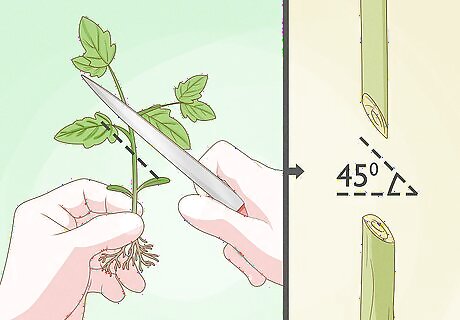
Cut each scion and rootstock stem at a 45º angle. Use a clean gardening knife to cut through the rootstock and scion stems. While it’s okay if the angle is a little off, try to cut the same angle for each stem so they fit together as closely as possible. Make the cut in one smooth motion to slice cleanly through the stem. Discard the top half of the rootstock and the bottom half of the scion plant. Cut each plant above the smaller "seed leaves" but below the full-size true leaves to prevent the scion from growing roots, which could lead to infection.
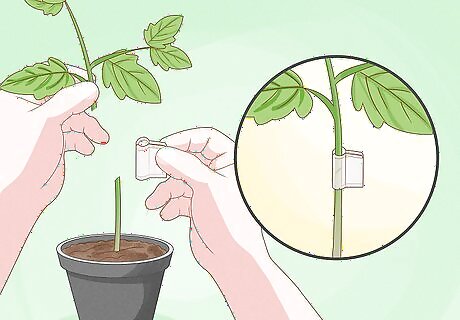
Join the two plants together with a grafting clip. Grafting clips are made from silicone or rubber and wrap around the stems to hold them together. Match the angles of the cut stems together and close the grafting clip around the union. Make sure the scion and rootstock are pressed together so they can heal as one plant.
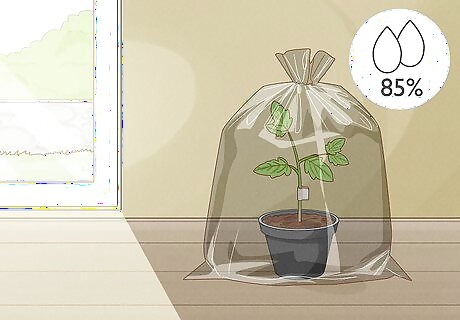
Move the grafted plant to the healing chamber. Keep the plant in the healing chamber so it has a humid, dark environment to grow in. That way, the two vascular systems of the plant can grow together, which allows the sap to flow through the stem without the risk of the scion losing any water or moisture. For 1 or 2 grafted plants, put a plastic bag over the plant and keep it out of direct sunlight. Water the base of the plant or mist its leaves when the humidity drops below 85%.
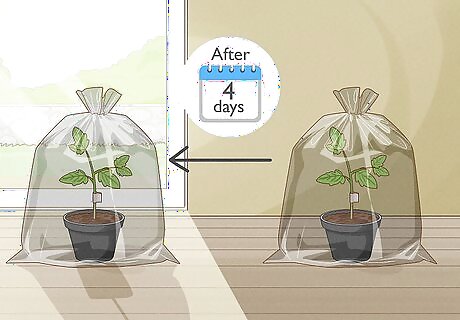
Increase the sunlight your plant receives gradually. Leave the newly grafted plant in the healing chamber for at least 4 days but it often takes a full week before the leaves return to a healthy state. After that, remove the shade cloth or move the plant to a sunny spot to increase the amount of light your plant receives during the day. Alter the humidity by occasionally removing a pan of water or lifting up the plastic bag a little higher. Wilting is normal for the first day, so don’t worry too much. Mist the plant's leaves, and if the plant continues to wilt for 3 or 4 days, the graft is most likely unsuccessful. Even though splicing is usually reliable, grafts still fail about 5% of the time even in the best of circumstances.
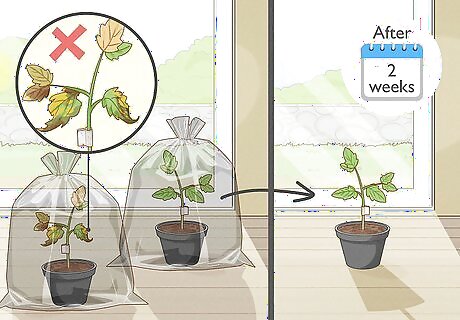
Return surviving plants to regular growing conditions after 2 weeks. Take any strong and healthy plants out of the growing chamber, and return them to normal growing conditions for the species you’ve planted. The exact conditions vary depending on the type of plant you’re growing.
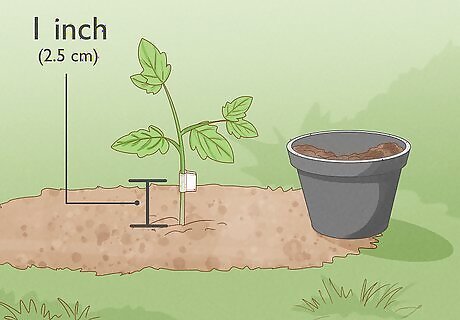
Plant the grafted plant so the graft clip sits well above the soil. Keep the point where the two plants are joined at least 1 inch (2.5 cm) above the soil to reduce the chances of the upper scion plant trying to grow roots. Just leave the grafting clip in place because it will fall off on its own as the plant grows larger. Do not hesitate to prune away roots growing from the scion or new shoots growing from the rootstock. You may also prune away smaller branches so more energy goes into fruit production.
Whip and Tongue Grafts
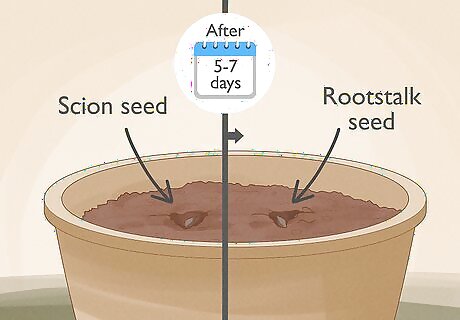
Plant the scion seed 5–7 days before the rootstock seed. As a general rule, the scion seed going on top of the graft grows faster, so plant it earlier than the rootstock seed if you’re growing your own. The specific variety of plant you’re growing may have different growing rates, so check beforehand to find the best times to plant. Whip and tongue grafts work best for melons and cucumbers, but it can also work well for apple trees and other woody fruit-bearing plants. Plant the seeds in small containers because the two plants are grafted together while each is still attached to its own roots, so they need to be able to reach each other without being transplanted.
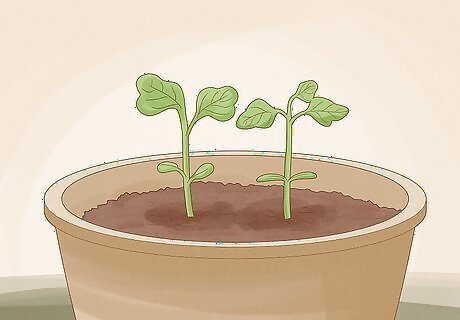
Wait to graft until plants have their first true leaf. The first leaves to emerge from a seedling are small seed leaves that do not look like the leaves of an adult plant. After one or two seed leaves have grown, a true leaf with a noticeably different shape will grow. When both plants have true leaves growing from their stem, they are ready to be grafted together. You'll have the highest chance of success if the stems of each plant are almost the same diameter and height, although it's not absolutely necessary.
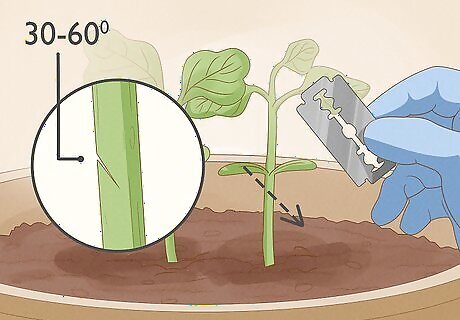
Cut partly through the rootstock with a clean gardening knife. Choose a point on the stem just below the seed leaf to make your cut. Slice approximately halfway through the stem, with a sharp downward angle between a 30º and 60º angle. Always sanitize the blade before and after you make your cut, and wear latex gloves to prevent the transfer of bacteria. This reduces the chance of infection to the plant.
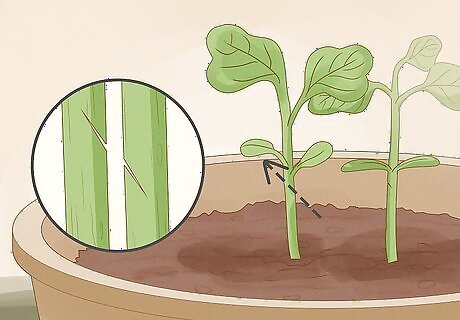
Make an upward cut at a matching angle partly through the scion’s stem. Choose a point below the seed leaf on the scion’s stem and cut approximately halfway through the plant with your razor blade. Angle the cut upward so the ends of the scion and rootstock can easily be joined together.
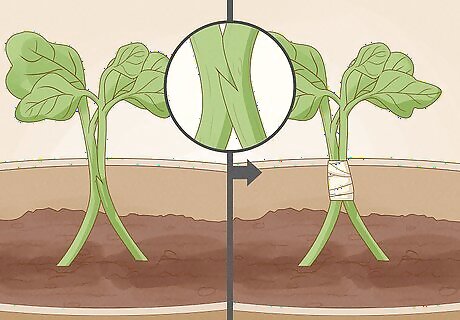
Hook the two plants together at the cut and secure them with a clip. Slide the upper "tongue" that you cut into the end of the scion plant into the wedge-shaped “whip” cut into the rootstock plant. Place a grafting clip around the joint or wrap it with grafting tape to protect the cut ends from bacteria and infections while the plants heal together. Label each plant, especially if the varieties look similar, so it’s easier to remember which parts to remove in the following steps.
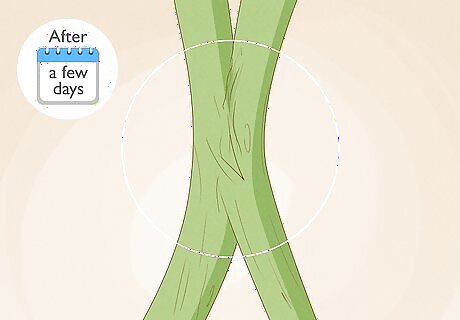
Allow the cuts to fully heal together. You do not need to place the cut plant into any special healing chamber or greenhouse since each plant is still able to transport water from its own roots to its leaves. Keeping your plants in greenhouse conditions according to the species you’re growing may still be a good idea, especially if you are growing a large number of plants.
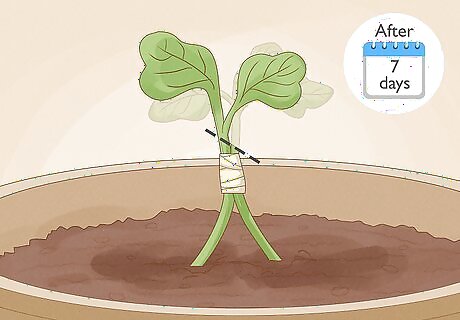
Remove the top of the rootstock plant after about 7 days. If your plant looks healthy and isn't wilting after 1 week, then the graft is most likely going to be a success. Use a gardening knife to cut off the top of the rootstock plant above the joint. Be sure to sanitize the blade after making your cut so you don’t spread bacteria between plants.
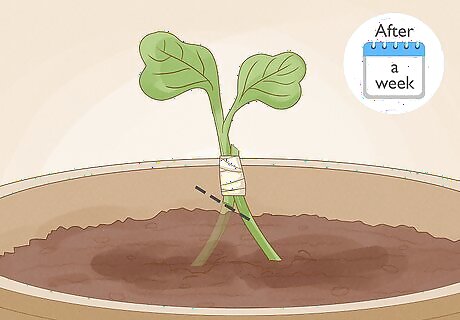
Remove the scion's roots. Keep an eye on the plant's health, and if the cut appears healed and the leaves are not wilted, cut off the scion's lower half below the joint. Usually, you can do this around the same time you remove the top of the rootstock. If the plant looks slow to recover or doesn’t have full leaves, wait a few additional days to cut the rootstock off.
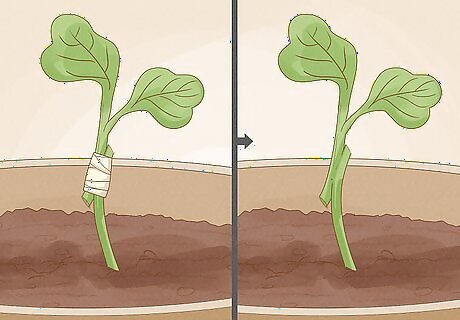
Remove the clip or tape after the cuts heal. Once the cuts have completely healed and joined the plants together, take off the clip or tape around the stem. Continue to care for your plant as you would an ordinary, un-grafted plant of the rootstock's variety.
T-Budding
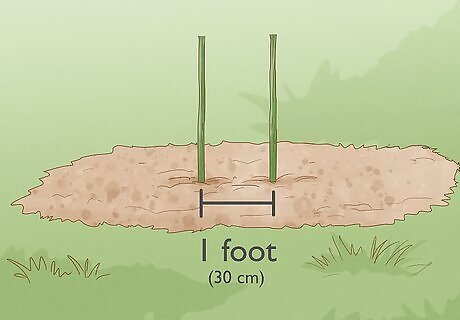
Plant the rootstock plants in advance. For roses and similarly sized plants, keep the rootstocks planted about 1 foot (30 cm) apart from one another. Keep the plants in a nursery bed and care for them according to the needs of the specific species and variety you’re growing. It doesn’t matter if you’re growing the plants from seeds or cuttings, as long as they’re planted enough in advance to have sizable, woody stems by the time the scion plant is budding. T-budding works great for plants like roses, citrus trees, and avocado trees. Unlike other forms of grafting, budding only requires the scion plant to form buds. This means the scion can be a different age or size than the rootstock without causing any problems
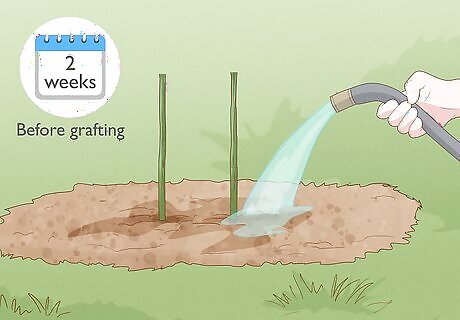
Graft the plants in cool weather when the scion plant is budding. T-budding usually works best in the later spring or early summer when the temperatures are still a little cooler and the scion plants are beginning to form buds. If the weather is hot and dry, water the rootstock plants heavily for two weeks before you plan on grafting so the bark is soft and easy to cut.
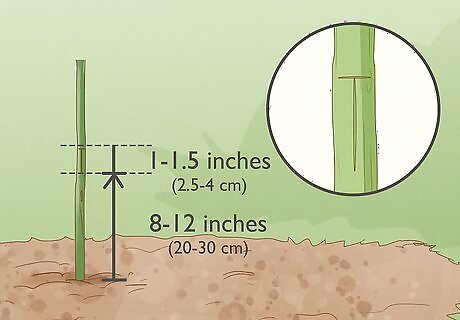
Make a T-shaped cut on the rootstock plant’s trunk. Choose a spot on the rootstock that’s about 8–12 inches (20–30 cm) above the ground. Make a vertical slice that’s around 1–1 ⁄2 inches (2.5–3.8 cm) long into the bark with a gardening knife. Then, make a horizontal cut about 1/3 the distance around the stem at the top of the vertical cut. This creates a flap of bar on each side of the vertical cut that can be lifted away from the trunk slightly. Roses and small flowering bushes may be cut 2–4 inches (5–10cm) above the ground instead. As always when cutting into the trunks or stems of plants, it's a good idea to use a sterilized, sharp knife and to wear latex gloves. This reduces the chance your plant will get infected.
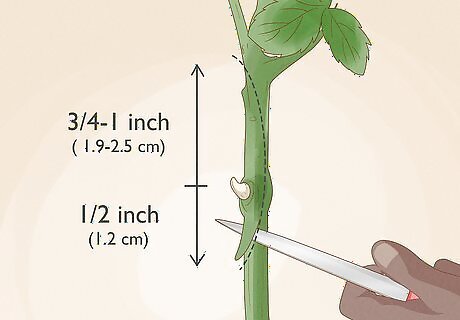
Cut a healthy bud and shoot from the scion plant. Select a shoot from the scion plant that is growing strongly and healthily, and remove one of its buds. Cut into the wood at a slight angle to remove a strip of wood beginning ⁄2 inch (1.3 cm) below the bud, and ending about ⁄4–1 inch (1.9–2.5 cm) above it. Carefully pull away this piece of wood, cutting it off from the branch if necessary.
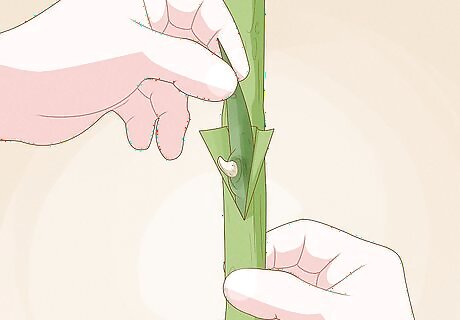
Insert the bud wood into the T-shaped cut on the rootstock. Gently ease the flaps of bark on either side of the T-shaped cut apart to reveal green wood underneath, called the cambium layer. Insert the strip of wood containing the bud, with the bud pointed upward, in between the flaps. Carefully push the bud into the vertical cut until the bud is just below the horizontal cut of the T. Each piece will have a layer of green wood pressing against each other. It may take a little practice to cut the plants to the correct level. One rootstock plant can receive several scion buds.
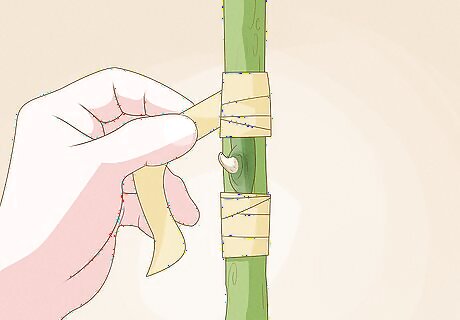
Tie the plants together with budding tape. Wrap the budding tape around the stem above and below the bud to hold the scion in place so it can heal and join with the rootstock plant. Do not cover the bud with the wrapping, or else it may not grow properly.
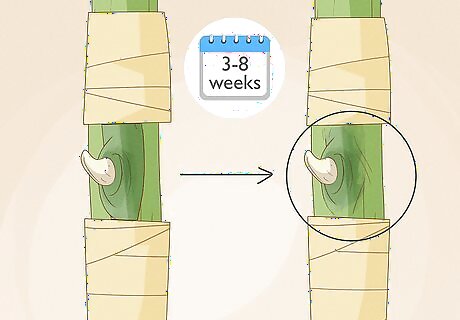
Wait 3–8 weeks for the plants to heal before removing the binding. The cuts will take anywhere from 3 to 8 weeks to fully heal and join together, depending on the weather and climate of the season. Once the plant looks healthy and the cuts have callused over, remove the tape from around the stem. While the plant is healing, just leave the tape around the point where the scion and rootstock are grafted together to keep bacteria and infections out.
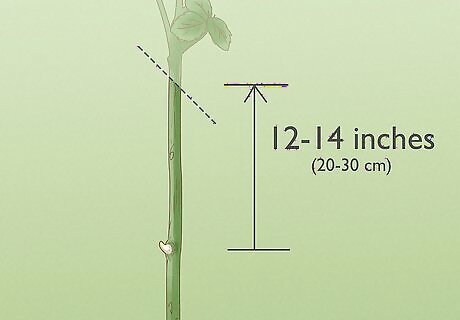
Cut the rootstock branch off above the new bud. Cut the rootstock stem off approximately 12–14 inches (30–36 cm) above where the bud was attached, or just few inches above it if you are working with a small plant. This "nurse branch" will help protect the vulnerable place where the two plants were joined. Cutting the top of the rootstock also prevents it from developing new shoots so its energy goes into making the bud grow stronger.
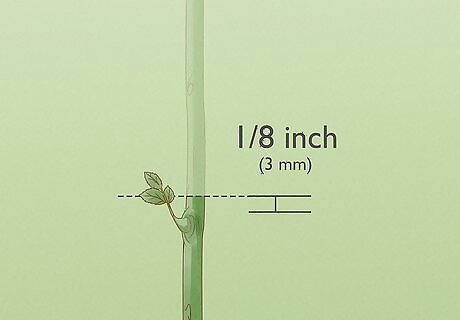
Remove the rest of the rootstock branch once the bud wood grows new leaves. It will take a few weeks for the scion to become established and grow a few new leaves. When it does, remove the remainder of the rootstock branch above the joint. Cut it down almost the entire way, to about ⁄8 inch (3.2 mm) above where the bud was joined. This will put all of the plant's energy into growing the new scion.




















Comments
0 comment